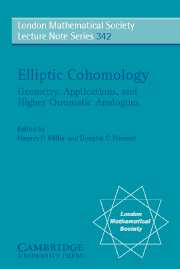Book contents
- Frontmatter
- Contents
- Preface
- Charles Thomas, 1938–2005
- 1 Discrete torsion for the supersingular orbifold sigma genus
- 2 Quaternionic elliptic objects and K3-cohomology
- 3 The M-theory 3-form and E8 gauge theory
- 4 Algebraic groups and equivariant cohomology theories
- 5 Delocalised equivariant elliptic cohomology (with an introduction by Matthew Ando and Haynes Miller)
- 6 On finite resolutions of K(n)-local spheres
- 7 Chromatic phenomena in the algebra of BP*BP-comodules
- 8 Numerical polynomials and endomorphisms of formal group laws
- 9 Thom prospectra for loopgroup representations
- 10 Rational vertex operator algebras
- 11 A possible hierarchy of Morava K-theories
- 12 The motivic Thom isomorphism
- 13 Toward higher chromatic analogs of elliptic cohomology
- 14 What is an elliptic object?
- 15 Spin cobordism, contact structure and the cohomology of p-groups
- 16 Brave New Algebraic Geometry and global derived moduli spaces of ring spectra
- 17 The elliptic genus of a singular variety
16 - Brave New Algebraic Geometry and global derived moduli spaces of ring spectra
Published online by Cambridge University Press: 03 May 2010
- Frontmatter
- Contents
- Preface
- Charles Thomas, 1938–2005
- 1 Discrete torsion for the supersingular orbifold sigma genus
- 2 Quaternionic elliptic objects and K3-cohomology
- 3 The M-theory 3-form and E8 gauge theory
- 4 Algebraic groups and equivariant cohomology theories
- 5 Delocalised equivariant elliptic cohomology (with an introduction by Matthew Ando and Haynes Miller)
- 6 On finite resolutions of K(n)-local spheres
- 7 Chromatic phenomena in the algebra of BP*BP-comodules
- 8 Numerical polynomials and endomorphisms of formal group laws
- 9 Thom prospectra for loopgroup representations
- 10 Rational vertex operator algebras
- 11 A possible hierarchy of Morava K-theories
- 12 The motivic Thom isomorphism
- 13 Toward higher chromatic analogs of elliptic cohomology
- 14 What is an elliptic object?
- 15 Spin cobordism, contact structure and the cohomology of p-groups
- 16 Brave New Algebraic Geometry and global derived moduli spaces of ring spectra
- 17 The elliptic genus of a singular variety
Summary
Abstract. We develop homotopical algebraic geometry ([To-Ve 1, To-Ve 2]) in the special context where the base symmetric monoidal model category is that of spectra S, i.e. what might be called, after Waldhausen, brave new algebraic geometry. We discuss various model topologies on the model category of commutative algebras in S, and their associated theories of geometric S-stacks (a geometric S-stack being an analog of Artin notion of algebraic stack in Algebraic Geometry). Two examples of geometric S-stacks are given: a global moduli space of associative ring spectrum structures, and the stack of elliptic curves endowed with the sheaf of topological modular forms.
Key words: Sheaves, stacks, ring spectra, elliptic cohomology.
MSC-class: 55P43; 14A20; 18G55; 55U40; 18F10.
INTRODUCTION
Homotopical Algebraic Geometry is a kind of algebraic geometry where the affine objects are given by commutative ring-like objects in some homotopy theory (technically speaking, in a symmetric monoidal model category); these affine objects are then glued together according to an appropriate homotopical modification of a Grothendieck topology (a model topology, see [To-Ve 1, 4.3]). More generally, we allow ourselves to consider more exible objects like stacks, in order to deal with appropriate moduli problems. This theory is developed in full generality in [To-Ve 1, To-Ve 2] (see also [To-Ve 3]).
- Type
- Chapter
- Information
- Elliptic CohomologyGeometry, Applications, and Higher Chromatic Analogues, pp. 325 - 359Publisher: Cambridge University PressPrint publication year: 2007
- 4
- Cited by



